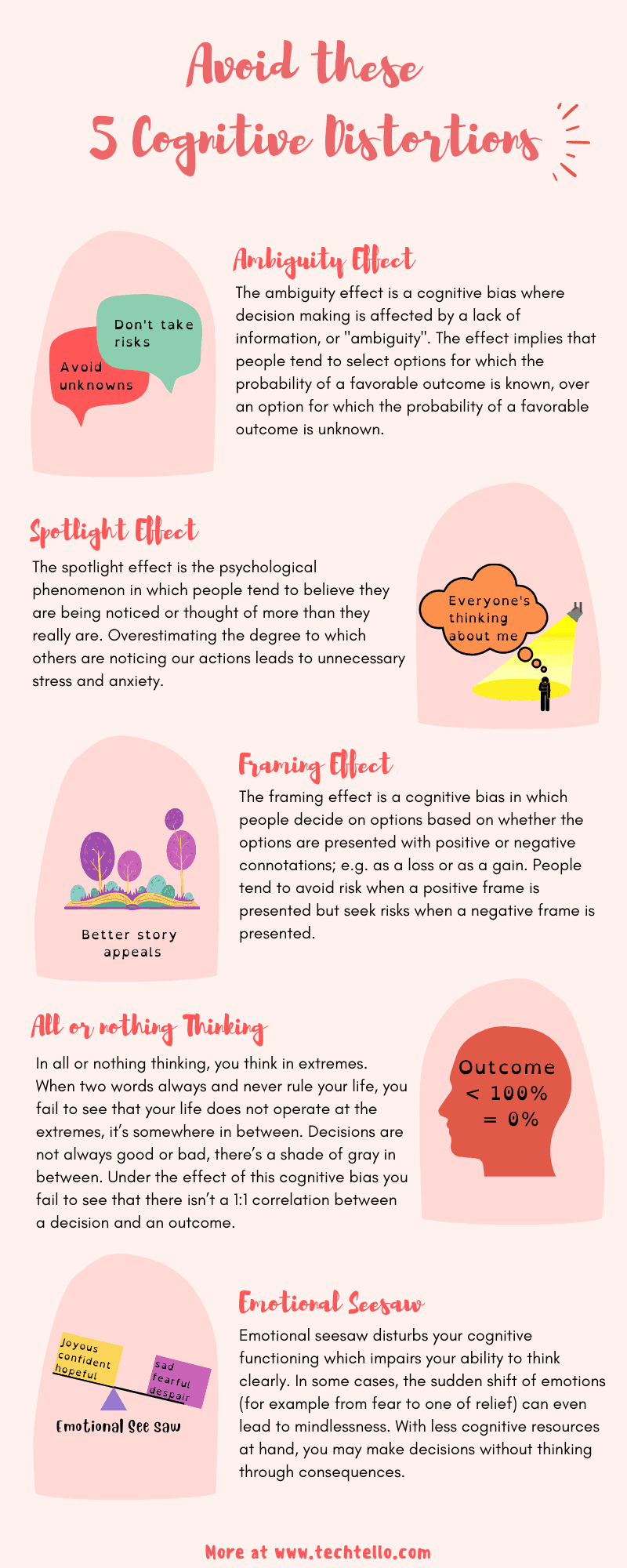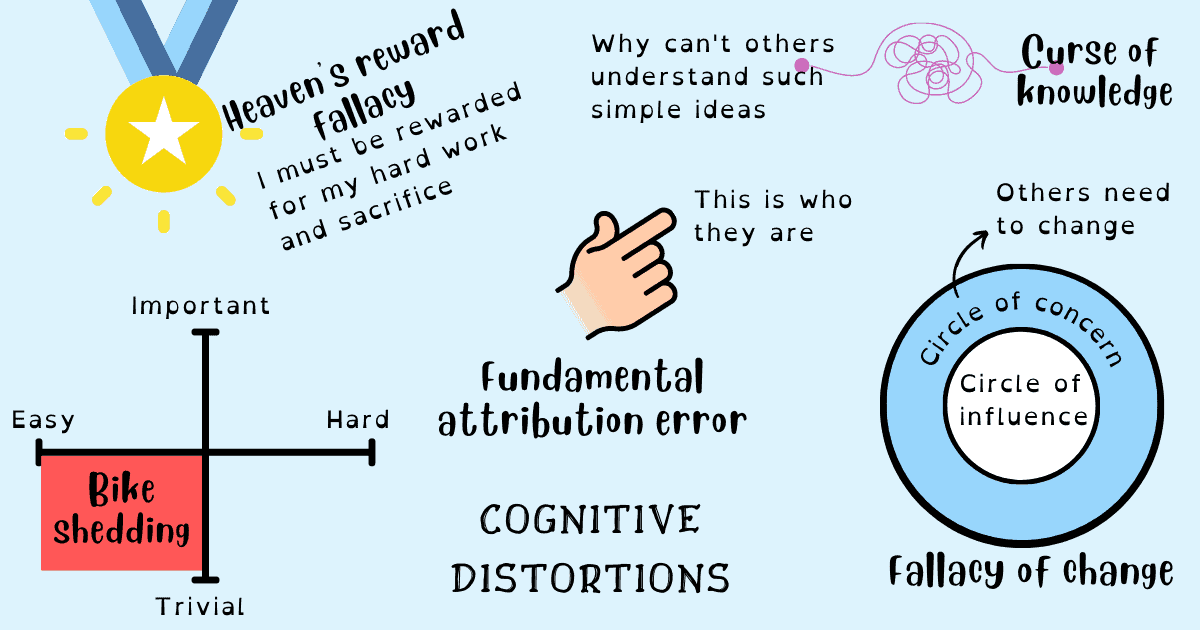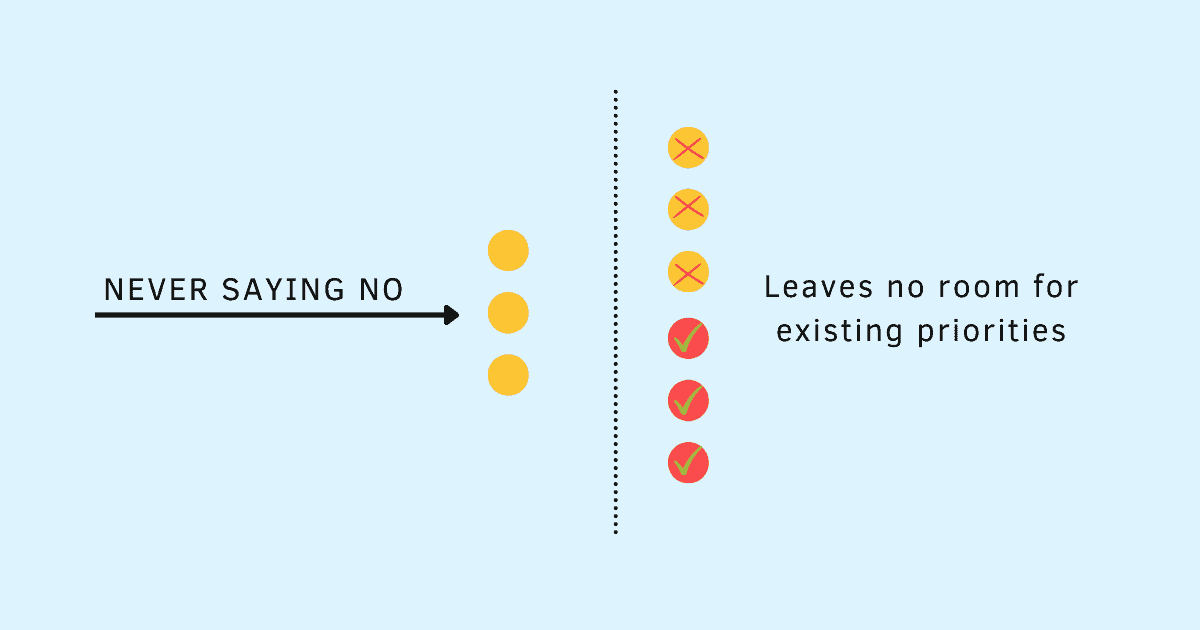Want to Make Better Decisions? Avoid These 5 Cognitive Distortions

We work in environments that aren’t optimized for solid decision-making. We also have irrational or negative thought patterns from time to time. This leads to habitual errors in thinking which creates an inaccurate view of reality.
From an evolutionary standpoint, human beings developed cognitive distortions as a survival method—adapting thinking for immediate survival made the human race come this far, but the same thoughts that served us well in prehistoric times are no longer relevant to the information and digital age we live in today.
Human beings have achieved some amazing feats in technology, medicine, food, agriculture etc etc but the neural circuits in our brain haven’t had enough time to catch up with the new realities.
There are many different causes of cognitive biases, but it’s our brains inclination towards mental shortcuts that plays a major contributing role.
Annie Duke writes in Thinking in Bets “Most of what we do daily exists in automatic processing. We have habits and defaults that we rarely examine, from gripping a pencil to swerving to avoid an auto accident. We need shortcuts, but they come at a cost. Many decision-making missteps originate from the pressure on the reflexive system to do its job fast and automatically. No one wakes up in the morning and says, ‘I want to be closed-minded and dismissive of others.’”
Combating these cognitive distortions during high stakes decisions or events where irrational thoughts have long term implications requires self awareness and practicing good habits of the mind which enable you to make conscious decisions as opposed to letting your brain run on autopilot.
In part 1, I will cover these 5 cognitive distortions
- Ambiguity effect
- Spotlight effect
- Framing effect
- Emotional seesaw
- All or nothing thinking
Let’s dive into each one.
Cognitive Distortions Bundle
Challenge and replace irrational thoughts with more realistic and adaptive thoughts.
Ambiguity effect
The ambiguity effect is a cognitive bias where decision making is affected by a lack of information, or “ambiguity”. The effect implies that people tend to select options for which the probability of a favorable outcome is known, over an option for which the probability of a favorable outcome is unknown.
We all dislike uncertainty and the discomfort that comes with not knowing how the outcome will turn out. This makes us play safe—opting for decisions with certainty while letting go of great opportunities involving risk.
Not taking risks stalls growth. Due diligence is important, but so is the ability to be bold and take calculated risks from time to time.
People early in their career make this mistake all the time. They’re afraid of failing and worry what mistakes would mean to their career. So they keep picking options they already know how to do well as opposed to going after opportunities that will help them grow and build new skills. The short term comfort that comes with doing things they have always done or where the risk of failure is low limits their long term growth.
Example of ambiguity effect cognitive distortion
Let’s say your boss gives you an option between two projects. One project has more clarity than the other, has a higher chance of success but the amount of learning is limited. The other project has many loose elements and success is not guaranteed. The opportunity to tackle the unknowns and connect the missing pieces should attract many, but the ambiguity effect makes most people opt for the safer option.
How to tackle it
To avoid the effect of this cognitive distortion, practice stepping out of your comfort zone—pick hard problems, purposefully put yourself in situations that make you uncomfortable and require you to get over the stress and anxiety that comes with not knowing how to do something. Doing this will build the mental muscle to embrace risks so that you no longer see unknowns as a threat, but rather an opportunity to reach for your potential and build new skills.
In short, less risk = less growth.
Spotlight effect
The spotlight effect is the psychological phenomenon in which people tend to believe they are being noticed or thought of more than they really are.
Overestimating the degree to which others are noticing our actions leads to unnecessary stress and anxiety. Assuming others are thinking about us and judging our behavior and actions prevents us from staying authentic or truly expressing ourselves.
This cognitive distortion makes us obsess about our past mistakes, the things we said or did. While we are focused on how others are judging us all the time, others are doing the same thing. They are so worked up about their own flaws and imperfections that they hardly have time to think about you.
An accurate evaluation of how much one is noticed by others is uncommon.
Example of spotlight effect cognitive distortion
Let’s say you gave the presentation to your group on an upcoming product line. Everything went well except one mistake that got highlighted during the discussion. Instead of being happy about how well it all turned out, your mind keeps drifting to that one moment where the mistake was pointed out.
The meeting is over and everyone has moved on but you can’t stop thinking about that one moment. Under the spotlight effect, your inner dialogue keeps repeating “How can I make that mistake? Everyone must think how stupid I am.”
How to tackle it
To avoid the effect of this cognitive distortion, instead of worrying about what others are thinking, remind yourself that no one really cares about you. Everyone is stuck in their own spotlight effect and have no cognitive capacity to put you in the spotlight.
In short, focus on doing your best work and stop worrying about what others are thinking.
Framing effect
The framing effect is a cognitive bias in which people decide on options based on whether the options are presented with positive or negative connotations; e.g. as a loss or as a gain. People tend to avoid risk when a positive frame is presented but seek risks when a negative frame is presented.
Even when multiple options are equally effective, depending on how the information is presented, what features are highlighted and how it’s framed, one can be more appealing than the other.
Framing effect makes us choose worse options that are better framed over options that are better but poorly framed.
As Daniel Kahneman, psychologist and economist notable for his work on the psychology of judgment and decision-making points out in Thinking, Fast and Slow “When directly compared or weighted against each other, losses loom larger than gains.” In other words, our automatic inclination towards loss aversion makes us avoid options with loss. So we naturally find the option that has positive attributes highlighted more attractive.
Example of framing effect cognitive distortion
For example: Let’s say two product managers present ideas for two new products to be developed. One PM states that there’s a 90% chance that the product will be a hit while the other states that there’s a 10% chance that it will fail. Under framing effect, even though both pieces of information point to the same outcome, you may choose the one with 90% success rate.
How to tackle it
To avoid the effect of this cognitive distortion, don’t make a choice based on how something is framed. Dig deeper, ask questions, evaluate them on other dimensions than the one being presented. Remind yourself: just because poor information is framed in a positive light does not make that option better. Doing this will not guarantee success, but the process will likely lead to a better choice.
In short, don’t fall for better storytelling and look beyond words.
All or nothing thinking
In all or nothing thinking, you think in extremes. You’re either a success or a failure. Your boss was either right or wrong. Your friend was either fair or unfair. You either win or lose.
When two words always and never rule your life, you fail to see that your life does not operate at the extremes, it’s somewhere in between. Decisions are not always good or bad, there’s a shade of gray in between.
Under the effect of this cognitive bias you fail to see that there isn’t a 1:1 correlation between a decision and an outcome—a good decision does not always lead to a good outcome and a bad decision may also sometimes lead to a good outcome.
As Annie Duke explains in Thinking in Bets “When we work backward from results to figure out why those things happened, we are susceptible to a variety of cognitive traps, like assuming causation when there is only a correlation, or cherry-picking data to confirm the narrative we prefer. We will pound a lot of square pegs into round holes to maintain the illusion of a tight relationship between our outcomes and our decisions.”
Example of all or nothing thinking cognitive distortion
Let’s say you decided to integrate the chat platform in your organization with a third party provider. At the time you made the decision, that company was doing really well and checked all your requirements. It appeared like a really good deal. However, just the next year the company changes its integration model and you realize that the set of features that were earlier promised to you will no longer be available. Even though the new chat platform meets a large part of your requirements, under the effect of “all or nothing thinking,” you may consider it a bad deal. You fail to realize that you made the best decision at that moment and there’s no way to predict the future.
How to tackle it
To avoid the effect of this cognitive distortion, don’t think in extremes—identify what matters and evaluate the trade offs of various options. Instead of a 100% guarantee that it will succeed, choose an option that makes the most sense at the moment.
In short, an undesirable outcome less than 100% is not the same as 0%.
Emotional seesaw
Emotional seesaw plays out in much the same way as experiencing a range of emotions while sitting on an actual seesaw as it goes up and down.
You may be hopeful one moment and feel despair the next. Some days you are unstoppable, other days you can’t seem to get off the ground. At times you’re energized and ready to take on the world, other times you get the feeling that everything around you is falling apart.
Getting sucked by your emotions disturbs your cognitive functioning which impairs your ability to think clearly. In some cases, the sudden shift of emotions (for example from fear to one of relief) can even lead to mindlessness. With less cognitive resources at hand, you may make decisions without thinking through consequences.
Example of emotional seesaw cognitive distortion
Let’s say you just discovered that you made a mistake at work which leads to a sudden rush of negative emotions like fear, shame and embarrassment. However, no one finds out your mistake which brings feelings of relief. When this happens, under the influence of the emotional seesaw you just experienced, your cognitive functioning is impaired. With less cognitive capacity at hand, the subsequent decisions you make will be less thought out, faster or made with little effort.
How to tackle it
To avoid the effect of this cognitive distortion, be watchful of strong emotions. When experiencing them, delay decision making or pause and consciously allocate resources to think through your decision instead of going with the easiest option or one involving the least effort.
In short, don’t let your emotions overwhelm you or control your thinking.
In life and business, the person with the fewest blind spots wins. Removing blind spots means we see, interact with, and move closer to understanding reality. We think better. And thinking better is about finding simple processes that help us work through problems from multiple dimensions and perspectives, allowing us to better choose solutions that fit what matters to us. The skill for finding the right solutions for the right problems is one form of wisdom — Shane Parrish, The Great Mental Models
This is part 1 in a series of cognitive distortions. Next week, I will share 5 more cognitive distortions that will help you see the flaw in your own thinking and enable you to practice clarity of thought and make better decisions.
Summary
- Cognitive distortions are thinking errors that lead to poor decisions and outcomes.
- Ambiguity effect makes you avoid risks and play safe, but it also limits your learning and growth.
- Spotlight effect makes you obsess about how you’re coming across to others as opposed to focusing on doing your best work.
- Framing effect makes you give more weightage to positive storytelling, but just because the story is good does not make it a better choice.
- All or nothing thinking discards anything less than a perfect outcome. Anything less than 100% is not 0%.
- Emotional seesaw depletes your cognitive resources making you fall for easy choices or the ones with low effort.






























